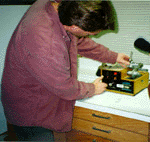Inaccurate estimates of fishes' ages
can cause mismanagement
For dead fish, biologists have estimated ages by counting
annual rings on scales or annual rings on otoliths (fish earbones).
But unlike trees, the rings on fish scales and otoliths may or may not be
annual: it depends on the species. With Pacific grenadier and other deep-water
fish, calibrating the ring-counting method by tracking live fish is impossible.
Researchers cannot be sure how many years one ring represents, and age estimates
for the Pacific grenadier range from six to 60 years old.
"If they are 60 years old," Andrews says, "You're
cutting down the old-growth fish."
Rapid exploitation of slow-growing deep-water fish can
be the recipe for a crash - which is what happened in New Zealand's orange
roughy fishery in the 1980s. Ellen Pikitch, Director of Fisheries Programs
at the Wildlife Conservation Society in New York City, says, "The longer
lived the fish is, the lower the fraction of the population you can harvest
on a sustainable basis."
When people began fishing orange roughy commercially, fisheries
biologists assumed the fish lived 20 to 30 years. That meant biologists
set the catch limits too high, because orange roughy actually lives over
100 years. That first - discovered orange roughy population got overfished
in fewer than five years. When people finally realized their mistake, "There
wasn't very much you could do about that stock," Pikitch says "It
will take a very long time to come back."

|

|
Allen Andrews uses a tiny diamond-bladed
saw to cut a small slice off an otolith. |
The otolith is a small crystal, about the size of a nickel,
that grows larger as material is laid down on the surface. Andrews is after
what he call "the birthday material" - just the small central
kernel at the otolith's core.
(from files of USNM) |

